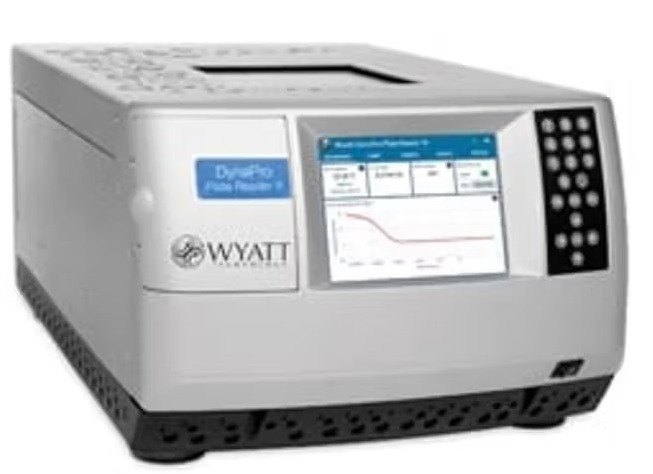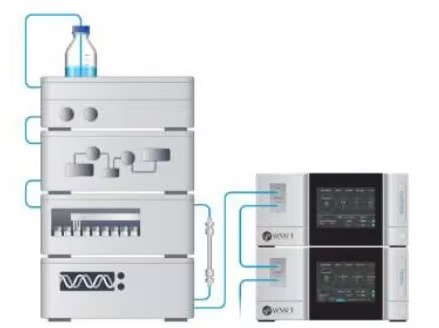各位老师,同学,
大家好!
动态光散射(Dynamic Light Scattering, DLS)技术是一种用于测量溶液中颗粒(如蛋白质、纳米粒子)大小及分布的光学技术。当一束激光照射到溶液中的颗粒时,颗粒会因布朗运动而导致散射光在时间上的强度波动。DLS通过检测这种散射光强度随时间的微小波动,计算相关函数,进而推算颗粒扩散系数,并计算出颗粒的水合直径(即动态粒径)。DLS实验通常在等温条件下进行,无需对样品进行固定或标记,适用于快速评估蛋白质的单体状态、聚集情况、均一性以及热稳定性等。其结果常以粒径分布图表示,可用于判断样品是否适合进一步的结构研究或筛选纯化条件。

尺寸排阻色谱-多角度光散射联用(Size Exclusion Chromatography coupled with Multi-Angle Light Scattering,MALS)技术是一种结合色谱分离与光散射检测的分析手段,用于测定生物大分子的分子量、构象和聚集状态等性质。实验过程中,样品首先通过尺寸排阻色谱(SEC)分离,不同大小的分子按体积依次流出色谱柱。随后,流出的组分依次进入多角度光散射检测器(MALS),该检测器在多个角度同时记录散射光强度,并结合浓度信息,直接计算出分子的绝对分子量,而不依赖标准曲线。SEC-MALS常用于判断蛋白质的聚集状态,评估蛋白质-配体或蛋白-蛋白复合物的组成与稳定性。

设备将于2025年7月10日进行联合培训。此次培训分为理论和上机两部分,因场地和时间受限,如确定参加请务必扫描下方二维码报名并回复邮件,以便我们安排工作。

当日具体安排如下:
理论培训时间:2025年7月10日9:30-11:30
理论培训地点:云栖校区1#215
上机操作时间:2025年7月10日14:00-17:00
上机操作地点:云栖校区1#224
祝好
晶体学平台
Dear all,
Dynamic Light Scattering (DLS) is an optical technique used to measure the size and size distribution of particles, such as proteins and nanoparticles, in solution. When a laser beam is directed at the particles in solution, their Brownian motion causes fluctuations in the intensity of the scattered light over time. By analyzing these fluctuations using autocorrelation functions, the diffusion coefficient of the particles can be determined, which is then used to calculate their hydrodynamic diameter (i.e., dynamic size). DLS experiments are typically conducted under isothermal conditions and require no labeling or immobilization of the sample. This technique is particularly suitable for rapid assessment of protein monodispersity, aggregation state, sample homogeneity, and thermal stability. The results are commonly presented as a size distribution profile, which can be used to determine whether the sample is suitable for downstream structural studies or for optimizing purification conditions.
Size Exclusion Chromatography coupled with Multi-Angle Light Scattering (SEC-MALS) is a powerful analytical method that combines chromatographic separation with light scattering detection to determine the molecular weight, conformation, and aggregation state of biological macromolecules. During the experiment, the sample is first separated by size exclusion chromatography (SEC), in which molecules elute from the column according to their hydrodynamic volume. The eluted fractions then pass through a multi-angle light scattering (MALS) detector, which simultaneously measures the scattered light intensity at multiple angles. By combining this data with concentration information, the absolute molecular weight of the molecules can be calculated directly, without reliance on standard curves. SEC-MALS is widely used to assess the aggregation state of proteins, to characterize the composition and stability of protein–ligand or protein–protein complexes, and to analyze the molecular properties of glycoproteins, polysaccharides, and other complex biomolecules.
Title:Application Traning for Dynamic Light Scattering and Size Exclusion Chromatography coupled with Multi-Angle Light Scattering
Time for theory learning: 9:30-11:30 a.m. July 10,2025
Venue: Room 215, Building 1, Yunqi Campus
Time for operation training: 2:00-5:00 p.m. July 10,2025
Venue: Room 224, Building 1, Yunqi Campus
Scan the following QR Code to join us, welcome!

Best regards,
Protein Characterization and Crystallography Facility.
